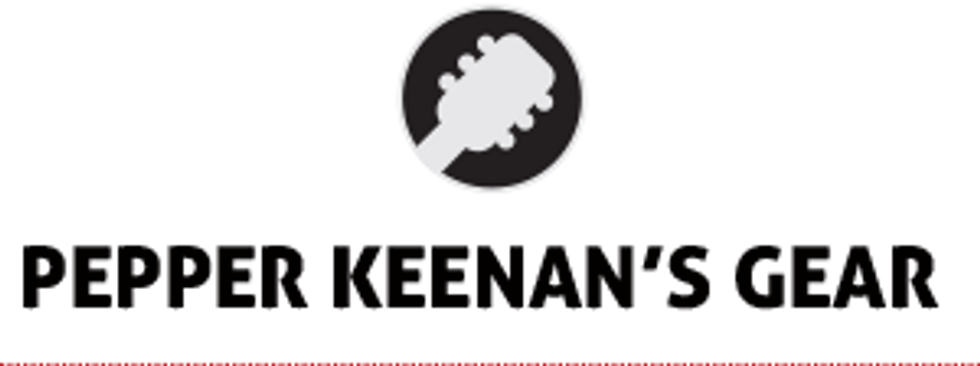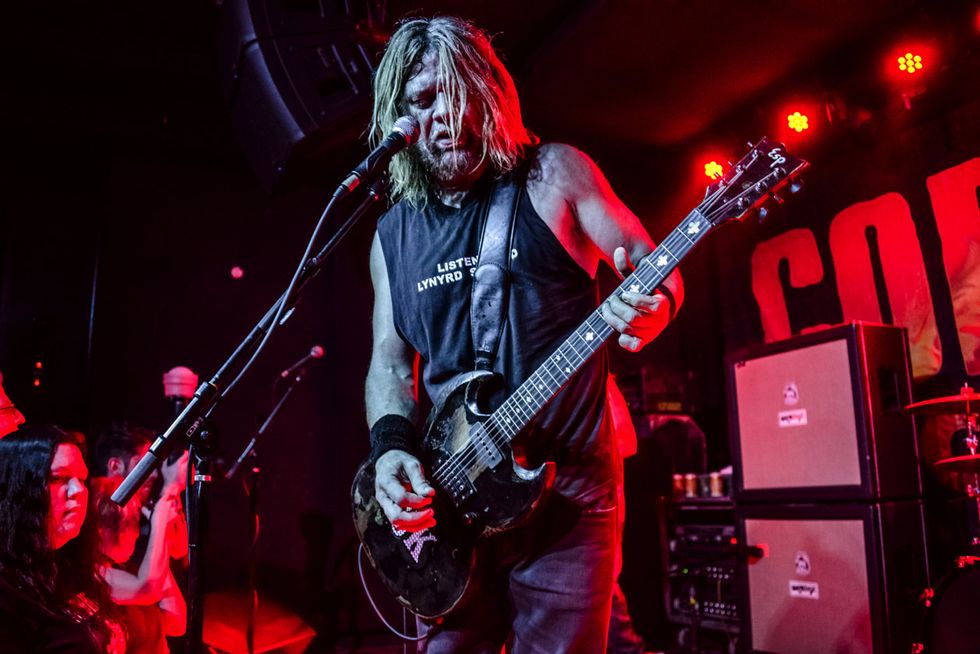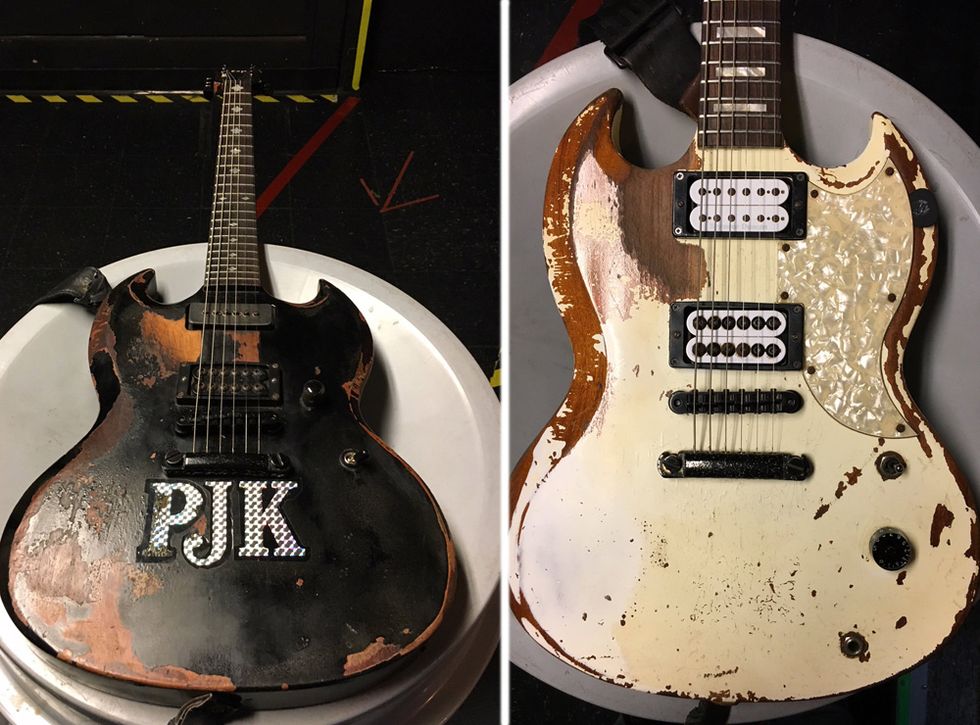The 1980s saw underground heavy metal claw its way into the American mainstream. And while household names like Metallica and Megadeth were exploding from the West Coast, Corrosion of Conformity (C.O.C.) were distilling their own brand of hardcore punk and metal, shaking the ground in their home state of North Carolina.
Though several singers came and went through the band’s early ranks, it was the core of Woody Weatherman on guitar, Reed Mullin on drums, and Mike Dean on bass that laid the groundwork for what would become one of the most influential hard rock bands of the 1990s. It was groundwork that would catch the ear of their soon-to-be bandmate, Pepper Keenan. “It’s the school Woody created,” admits Keenan in his signature Southern drawl. “I mean, back in the day, when they were doing [1985’s] Animosity, I was way into that.”
The band added the New Orleans native on guitar in 1991, and subsequently released their third album, Blind, which signaled a dramatic shift to a more Southern-tinged metal sound. This was most evident on the fan favorite “Vote With a Bullet,” which also served as Keenan’s debut on lead vocals. Knowing that their new sonic assault had hit on something big, C.O.C. quickly jettisoned their then-current singer and soldiered on with Keenan front and center.
What followed was C.O.C.’s breakthrough album, 1994’s Deliverance. Produced by John Custer—the band’s honorary fifth member—Deliverance introduced the world to a hard-edged sound that was equal parts Lynyrd Skynyrd, Black Flag, and Black Sabbath. Songs like “Albatross,” “Clean My Wounds,” and “Broken Man” defined the band and are still featured heavily in its live sets today.
—Woody Weatherman
Throughout the next 11 years, C.O.C.’s four-man lineup continued to expand its sound with each new album while never letting go of what put them on the map. Their Allman Brothers-style harmonized guitar lines, down-tuned aggression, and Keenan’s recognizable yowl were always on full display. But it took until 2005’s In the Arms of God for the band to release an album that rivaled the power and intrigue of Deliverance. With its gargantuan riffs, swampy grooves (featuring Galactic’s Stanton Moore on drums, filling in for a temporarily departed Mullin), and Keenan’s ferocious vocal delivery, In the Arms of God became the recording by which the band’s future would be judged.
There was a truncated tour in support of the album, but then Keenan went on hiatus—never officially leaving the band, but making only rare appearances with his ’mates on stage. Weatherman and Dean soldiered on, and Mullin resumed touring with C.O.C in 2009. As a trio, they made two more albums.
Fast-forward to the present, and the simple sound of a heartbeat opens one of the most anticipated new releases in heavy metal, No Cross No Crown. Straight out of the gate, rockers like “The Luddite” and “Cast the First Stone” assuage any fears that the foursome wouldn’t live up to the powerful note they went out on. You want C.O.C.’s Sabbath-influenced grind? Hit play on “E.L.M.” The band’s calling-card melodic interludes are represented in “No Cross,” “Matre’s Diem,” and “Sacred Isolation.” And to round it out, the album closes with a cover of Queen’s “Son and Daughter,” a song that seems custom-written for the pulverizing, churning sound of this recording.

For their 10th studio album, C.O.C. kept it real, tracking each song with dual guitars. “On this record, we did it like we were doing demos,” says frontman Pepper Keenan. “We were literally writing things off the cuff.”
When Premier Guitar spoke to Keenan and Weatherman about No Cross No Crown, the band’s tenth studio opus, it quickly became apparent this wasn’t simply a reunion cash grab, and the reinvigorated group of Southern boys were glad to be back together.
After completing In the Arms of God, the band fragmented. What caused that and what brought you all back 13 years later?
Woody Weatherman: We never really discussed it. We just went home and chilled for a while. Of course, Keenan was busy with Down [a band that includes Phil Anselmo of Pantera]. Early on, we had talks that Keenan kind of spearheaded about doing a couple things, but we couldn’t quite make it happen. So the three of us, Mike, Reed, and myself, did a couple records and traveled around for a couple years. But it was always with the intention of getting back with Pepper. And I guess it was late ’14 or early ’15 when we said, “Man, let’s go out and see how it feels.” And we just kept touring for two solid years without a record or anything. Eventually we realized, “Okay—it’s time to do a fucking record.” And that’s when we started working on No Cross No Crown.
Pepper, what was it that brought you back to the band?
Pepper Keenan: Well, when we did In the Arms of God, three days before we were supposed to leave to do a massive two-and-a-half-month tour with Motörhead, Hurricane Katrina hit. So I had to fly to New Orleans. Everything got fucked up and that really took a toll on us. After that, Sanctuary—the record label that the album was on—fell apart. Unfortunately, things happen, and that’s just kind of how it went. So I did Down stuff. When the moment came where I had some time, I spoke with the C.O.C. guys to see if they wanted to play together again.
The four of you hadn’t recorded together since America’s Volume Dealer, which was released in 2000. What was it like getting all of you back in a studio to make music?
Keenan: It was cool. We just made a big list of what songs we wanted to learn. We met in North Carolina and just started hacking at it. Everybody was in good shape and we started knocking them out. We had fun and kept it at that.
Like his 6-string sidekick, Woody Weatherman, Pepper Keenan plays a battered ESP Custom Shop Viper. “They’re just battle axes,” he says, “but you can get a million different tones on them.” Photo by Annie Atlasman
The album has your trademark raw feel. What was the recording process like?
Weatherman: It was really different than how we had done past albums. A lot of times, you demo things over and over, and then you go in and do the real record. And quite often you look back and go, “Man, the demo is fucking rawer and almost better!” So we were going along like we were doing a demo, but treating it like we were doing an album. And it just worked out. I wouldn’t shy away from doing it that way again. I kind of enjoyed it.
Keenan: Yeah. On this record, we literally did it like we were doing demos. We would go in there with no preconceived idea. If we had a riff, we’d shape it into a song and get Reed to perform the drums. We were literally writing things off the cuff. The entire record is like that. There was nothing that we re-tracked. Everything we did, we wrote at that moment, spent time on it, completed it, and went to the next song. So every song was completely different. And that’s a very tall order.
That’s one of the first things that struck me about the album. Every song, while definitely Corrosion of Conformity, sounds completely different.
Keenan: And that was a very conscious thing. We did not want to make a record where the guitars were the same on every damn song. But we did—literally—track the record with two guitars.
—Pepper Keenan
What guitars were they?
Keenan: Just the same junkers we’re playing onstage right now. The ESP SGs [a model officially called a Viper] that they had made for us when we did the Metallica tour in ’97. They’re just battle axes, but you can get a million different tones on them. We probably shouldn’t even have them out here, but they play so damn good. We actually sent them back to ESP because they were so beat-to-shit. They were stunned that we still had them. They refurbished them. I said, “Don’t touch the fucking wood, but you can replace everything else.”
Weatherman: That’s all I use live, and that’s all I fucking use in the studio. I’ve got one guitar, man. If it ever breaks, my career is over! [Laughs.] I mean, I’ve got a couple, but that’s the only one I like playing. I’ve had the damn thing for 25 years or something, and I haven’t found anything better. I’m not much of a gearhead. I’ve got the same old-ass-shit that I’ve had for fucking ever. My two Mesa/Boogie Dual Rectifiers are the old original ones. And that’s my shit man. I plug that old-ass guitar in and go. The only thing I use live is a Cry Baby. Just a standard old, Joe Schmoe, nobody’s-name-on-it-other-than-Jim-Dunlop Cry Baby.
With only two guitars, how did you go about getting all of the tones on the album?
Keenan: All the clean shit you hear on some of those solos and mellow parts, that’s just the volume rolled back and stepping on the pedal to get rid of the overdrive. Woody had a Mesa/Boogie [Dual] Rectifier, and I just used channel B on an Orange Thunderverb 50.

Guitars
1997 ESP Custom Shop Viper “PJK” with Seymour Duncan Invader (bridge) and unused P-90 (neck)
Amps
Orange Thunderverb 50 head
Orange PPC412 cabinet with Celestion Vintage 30s
Effects
Ibanez TS808 Tube Screamer
Boss DD-3 Delay
MXR Phase 90
Dunlop Cry Baby 95Q Wah
Keeley 30 ms Double Tracker
Strings and Picks
Dean Markley custom set with wound 3rd (.011–.052)
InTuneGP GrippX Model XXXb Tri-Tips (.73 mm)
And how about cabinets?
Weatherman: I’ve got these awesome Orange cabs with Vintage 30s. I love the way they sound. I had a bunch of old Marshalls, and I’ve even tried the Boogies. Even if they have the Vintage 30s in them, they just don’t sound as thick and heavy as the Oranges. Those things are brutal. And the Vintage 30s is where it’s at. That’s a big part of the crunch, having that speaker breakup like that. Pepper has some actual orange ones and mine are black. But other than that, I think they’re the same.
Pepper, on previous albums, you were using Mesas, too, weren’t you?
Keenan: Yeah. I had the 50 Caliber with the 5-band EQ.
What led to the switch to Orange?
Keenan: I was at a NAMM show with Kirk [Windstein of the bands Crowbar and Down], and we went to the Orange booth. The guy recognized me and Kirk and was like, “Dude, check this sucker out!” I plugged in that Thunderverb 50, no pedals or anything, and just raked a G chord. It sounded like fucking Malcom Young! I just knew right there. We actually got kicked out of the NAMM show for being at the Orange booth and playing so fucking loud.
Do you get all your drive from those amps, or do you use pedals?
Keenan: I use the Ibanez Tube Screamer. It just makes it more pissed. And then I have a Phase 90 and one of those Dunlop wah-wahs that you just lean into. And I have a Boss delay. And then I have a really good doubler pedal that someone suggested. I’ve been trying to find a pedal that sounds like a Cooper Time Cube forever, but hadn’t had any success. But someone recommended this pedal, and it’s pretty damn close. I use that for solos on “Albatross” and shit like that.
That phaser is a massive part of C.O.C.’s sound.
Keenan: Yeah. We just used my pedalboard in the studio. Woody doesn’t have one, so we just sat down in the control room and dicked off with that thing. But we’ll do tricky shit like double-track it and put the phase knob a little more to the right on the second track. That’s Custer’s crazy shit, trying to get things to spread out and sound big. Or we’d do a track with a wah pedal halfway down just to get the crunch from the pick hitting the string. A lot of overdubs on the record are done really incorrectly. [Laughs.]
Though Pepper Keenan’s ’97 ESP “PJK” Viper (left) has a P-90 neck pickup, he never uses it, relying instead on the Duncan Invader bridge humbucker. “I’ve had the damn thing for 25 years or something, and I haven’t found anything better,” says Woody Weatherman of his road-worn ’97 ESP Viper (right), which sports Duncan Invader and Pearly Gates humbuckers.
Woody Weatherman uses only one pedal onstage: “Just a standard old, Joe Schmoe, nobody’s-name-on-it-other-than-Jim-Dunlop Cry Baby,” he says. Photo by Annie Atlasman
With so many guitar tracks, how do you guys determine who plays what?
Keenan: Depends. If it involves “the wiggle”—vibrato—it’s going to be Woody. If it involves more bendy, bluesy shit, it’s going to be me. We’ve done shit before where we literally hand the guitar back between each other on the same track. So it won’t be Woody’s track or Pepper’s track. It will be Woody’s and Pepper’s track. We’ll just play each other’s parts through the song.
So there are no defined, ‘I’m the rhythm guy, you’re the lead guy,’ roles?
Keenan: Fuck no.
Woody, how did you develop that unique vibrato?
Weatherman: I don’t know how that came about. I think a large part was, I heard people playing pedal steel and slide guitar. I was never able to do that shit. So I was like, “How can I make it sound like that, but without a slide?” Then I thought, “Well, if I wiggle my wrist really fucking hard, maybe it will sound like it.” [Laughs.] And listening to [Billy] Gibbons and all that shit. I wanted to be able to do that.
There’s an identifiable sound that runs through all your songs. Is that something you guys work to maintain, or simply a natural outgrowth of your styles and influences?
Keenan: I think it’s a little bit of both. Once we hit our stride with Deliverance, we knew we were on to something. A lot of the punk-rock kids called us fucking sellouts and crap. But to me, being punk rock was writing a song like “Albatross.” You know?
Now you’re really putting your dick on the chopping block. And once we started writing things like “Albatross,” we knew we were starting to create an identity. I think it’s an important thing when you can hear a song and go, “Oh. That’s so-and-so,” even if you’ve never heard the song before. So that’s something we subconsciously work on.
Weatherman: And we know within 10 minutes if it’s working. I remember going in to do the Blind album. It’s 1990, we’re up in New York, we’re working on the record. We would spend hours agonizing over getting a guitar tone. Now, we just set our shit up, and if it’s not there in five minutes, we know. It’s not hard if you have half an idea of what you’re looking for.
The band hit on something big with In the Arms of God. When you started writing this album, did you feel pressure to try to recreate that magic?
Keenan: In the Arms of God was definitely a catalyst. I made that real clear. I said, “Dude, that’s a damn tough record. I’m not saying we’re going to trump this thing, but that’s where we’re starting from.”
Weatherman: Any pressure was coming from ourselves. The guys at [the record label] Nuclear Blast were like, “Take your time. We know that when you’re done, it’s going to be cool.” So there was no pressure from those dudes. From there it was on ourselves. We thought, “Let’s get our minds where we left off.” Then we just jumped off the diving board and whatever happened, happened.

Guitars
1997 ESP Custom Shop Viper with Seymour Duncan Invader (bridge) and Pearly Gates (neck) Amps
Amps
Mesa/Boogie Dual Rectifier head
Orange PPC412 cabinet with Celestion Vintage 30s
Effects
Dunlop Cry Baby
Strings and Picks
Dean Markley custom set (.011–.052)
Lyrically, your songs have always tackled politics and religion. But on No Cross No Crown there seems to be a concept that runs throughout the album, both lyrically and melodically.
Keenan: I just like making thought-provoking, big records. Once we had the idea of No Cross No Crown, it was just about how much damage has been done by the cross and the crown across the centuries, and how relevant that is these days. It’s just a way of saying that we’ve got to find a way of getting back to basics and back to being human beings. We’ve got to take care of each other. I didn’t want to be singing about killing people and tanks and bullshit like that. I tried to put it on a different level. But in terms of the lyrical aspect of it, we’re not standing on the soapbox telling people what to do. They can pull anything they want out of it.
Now that you’ve had a chance to road-test these new songs, how has the reaction been from your audience?
Weatherman: This entire tour has been awesome. Good crowds. And we’re reaching some new fans, which is kind of crazy. There will be a few people every night that are like, “Man, I’ve heard your name, but I’ve never seen you.” And that’s cool! So it’s a good tour for us, when we can reach out to some new folks.
What about the future of C.O.C.? Can we expect another album with Pepper at the mic?
Keenan: When you put out a record like this one, I don’t even want to think about trying to do it again. I was extremely ecstatic when I heard No Cross No Crown finished. I was like, “We did it, goddamnit. I don’t know how, but we fucking did it.” [Laughs.] Our standards are so high that it will wear your ass out, mentally. I mean, we came in there with nothing. Then nine months later, we walked out with that.
Weatherman: Our plan is, for the next year or more, we’re touring. Whenever you put out a record and you feel really good about it, you want to get out and support it and be behind it for a while. So that’s our plan right now. After that, who knows? We’ll see. Hopefully there’s more records in the future. But right now, it’s the live thing we’re concentrating on.
Woody, you helped found the band over 30 years ago. After all this time, after huge albums and devastating hurricanes, after years on the road and years apart, what keeps Corrosion of Conformity going?
Weatherman: I love it—it’s been my life. We cranked this thing up in ’82. It’s what I do. I love the opportunity to play music for the fans, getting to travel, meeting people every night, going out and hanging with people every night. You get an ear full, you know? You see what’s going on, you learn things, you get to see different bands, you get to see new bands. It’s a dream. I’m living the dream, brother.
A haunting introduction paves the way for C.O.C. to tear through one of the most punishing tunes from No Cross No Crown, with Woody Weatherman and Pepper Keenan flaying their roadworn ESP Vipers.














![Rig Rundown: Russian Circles’ Mike Sullivan [2025]](https://www.premierguitar.com/media-library/youtube.jpg?id=62303631&width=1245&height=700&quality=70&coordinates=0%2C0%2C0%2C0)



![Rig Rundown: AFI [2025]](https://www.premierguitar.com/media-library/youtube.jpg?id=62064741&width=1245&height=700&quality=70&coordinates=0%2C0%2C0%2C0)












 Shop Scott's Rig
Shop Scott's Rig








 Zach loves his Sovtek Mig 60 head, which he plays through a cab he built himself at a pipe-organ shop in Denver. Every glue joint is lined with thin leather for maximum air tightness, and it’s stocked with Celestion G12M Greenback speakers.
Zach loves his Sovtek Mig 60 head, which he plays through a cab he built himself at a pipe-organ shop in Denver. Every glue joint is lined with thin leather for maximum air tightness, and it’s stocked with Celestion G12M Greenback speakers.












![Devon Eisenbarger [Katy Perry] Rig Rundown](https://www.premierguitar.com/media-library/youtube.jpg?id=61774583&width=1245&height=700&quality=70&coordinates=0%2C0%2C0%2C0)






